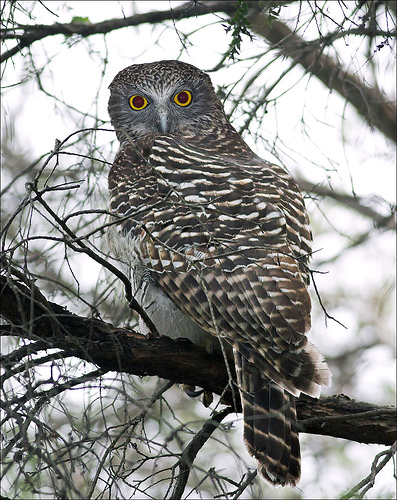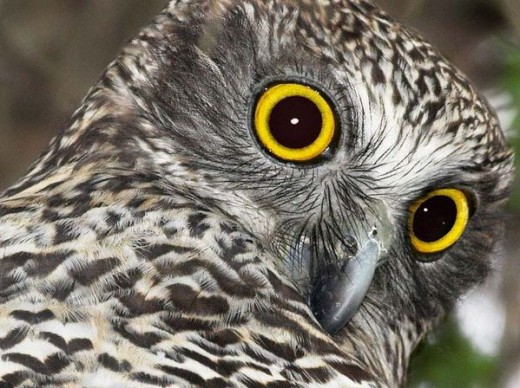Powerful Owls – disappearing Australians
 Australia’s Powerful Owl (Ninox strenua)
Australia’s Powerful Owl (Ninox strenua)
.
Like many native species in Australia, the Powerful Owl’s conservation status is deemed to be ‘Vulnerable’.
It remains the largest owl in Australasia, endemic to eastern and south-eastern Australia (that is it lives naturally nowhere else on the planet).
Now uncommon throughout its range where it occurs at low densities preferring woodland and open sclerophyll forest to tall open wet forest and rainforest.
The Powerful Owl requires large tracts of forest or woodland habitat but can occur in fragmented landscapes as well. The species breeds and hunts in open or closed sclerophyll forest or woodlands and occasionally hunts in open habitats. It roosts by day in dense vegetation comprising species such as Turpentine Syncarpia glomulifera, Black She-oak Allocasuarina littoralis, Blackwood Acacia melanoxylon, Rough-barked Apple Angorphora floribunda, Cherry Ballart Exocarpus cupressiformis and a number of eucalypt species.
.
The main prey items are medium-sized arboreal marsupials, particularly the Greater Glider, Common Ringtail Possum and Sugar Glider. There may be marked regional differences in the prey taken by Powerful Owls. For example in southern NSW, Ringtail Possum make up the bulk of prey in the lowland or coastal habitat. At higher elevations, such as the tableland forests, the Greater Glider may constitute almost all of the prey for a pair of Powerful Owls. Birds comprise about 10% of the diet, with flying foxes important in some areas. As most prey species require hollows and a shrub layer, these are important habitat components for the owl.
.
Pairs of Powerful Owls are believed to have high fidelity to a small number of hollow-bearing nest trees and will defend a large home range of 400-1450 ha.
Powerful Owls nest in large tree hollows (at least 0.5 m deep), in large eucalypts (diameter at breast height of 80-240 cm) that are at least 150 years old. During the breeding season, the male Powerful Owl roosts in a “grove” of up to 20-30 trees, situated within 100-200 metres of the nest tree where the female shelters.
.
Unlike many humans, Powerful Owls are monogamous and mate for life, making them a superior species.
.
Human Threats to Powerful Owls
...
Powerful Owls have for decades been threatened by the human caused ongoing loss and fragmentation of habitat. Important forest and woodland habitat continues to be cleared and burned for reasons justifying human residential and agricultural development. This loss also affects the populations of arboreal prey species, particularly the Greater Glider which reduces food availability for the Powerful Owl.
Inappropriate forest harvesting practices that have changed forest structure and removed old growth hollow-bearing trees.
Loss of hollow-bearing trees reduces the availability of suitable nest sites and prey habitat. Can be extremely sensitive to disturbance around the nest site, particularly during pre-laying, laying and downy chick stages. Disturbance during the breeding period may affect breeding success.
High frequency hazard reduction burning is also reduce the longevity of individuals by affecting prey availability.
.
In 2007, the New South Wales Labor Government in its State Transit department was found to have poisoned many powerful owls and other wild birds around Ryde in its so-called pest control plan.
.
‘The government-owned agency employed a poison expert to kill pest Indian mynah birds at their bus depot in Ryde but local residents watched in horror as kookaburras, galahs, magpies and rosellas started falling out of the sky.’
‘A spokeswoman said the last poisoning campaign, using baited bird seed, was on November 12.’
[Source: ‘Bird-brained system killing wildlife’, The Daily Telegraph, 14th December 2007, http://www.dailytelegraph.com.au/news/sydney-nsw/bird-brained-system-killing-wildlife/story-e6freuzi-1111115108124 ]

Tags: aphid poison, bird poisoning, Indian Mynah, Ninox strenua, Powerful Owl, Ryde Bus Depot, Sydney Buses, Transport Minister John Watkins










We moved 2 a 4 acre property in Dollar,Victoria and have just had a Powerful Owl visit us here tonight 10th April at about 7 30p.m. It is a beautiful bird and just wanting 2 know if its found regularly here in South Gippsland. We r half way between Leongatha and Mirboo North.
Steven,
I would check with your local wildlife rescue group or bird watching group in your area.
They would be the best to ask as they will have local knowledge =)